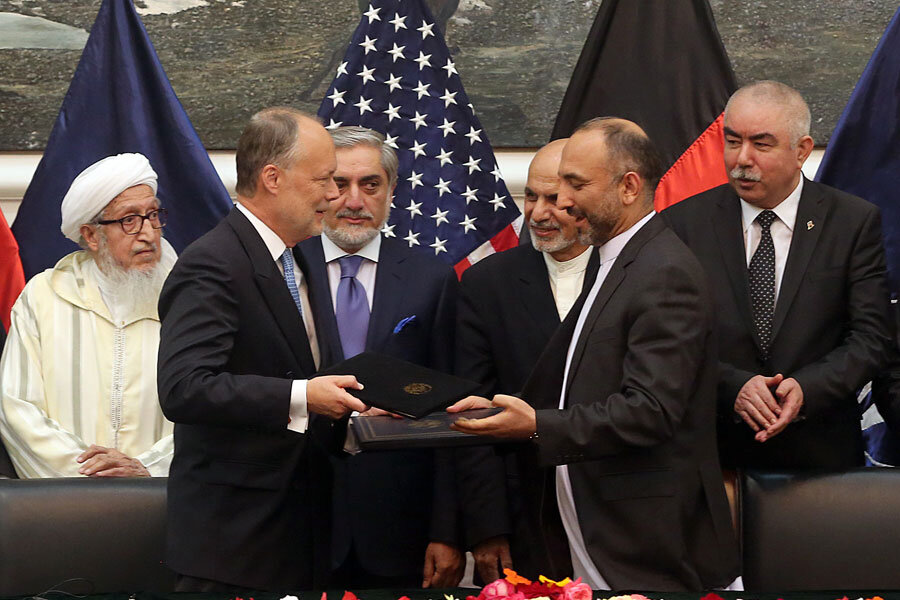US-Afghan security deal signed: why it's small, but important
Loading...
| Washington
On the face of it, the pact the United States and Afghanistan signed Tuesday to keep about 10,000 US forces in Afghanistan past 2014 doesn’t do all that much.
Under the agreement, the US forces will be limited to two functions: continued training of Afghan security forces and counterterrorism activities.
But that short “to do” list does not hint at the more intangible role of the agreement as a confidence builder for key groups of Afghan society – from the women and girls who are participating in the economy and politics and going to school in greater numbers to a budding entrepreneurial class and a young class of military officers. Their fear? A US departure would mean the international community was about to abandon Afghanistan.
With the decade-long NATO mission in Afghanistan ending in December, the US agreement also paves the way for other NATO (and non-NATO) countries to unveil their post-combat commitments to training Afghan security forces.
That larger but unstated goal was present in comments from new Afghan President Ashraf Ghani, who said that the accord “replaces uncertainty with certainty” concerning relations with the US and the world. Insisting the pact does not compromise Afghanistan’s sovereignty, Mr. Ghani said “the right to use force” remains with Afghan authorities. He also noted that either side has a right to withdraw from the pact.
Within minutes of the signing, Afghan security officials signed a similar accord with NATO that will allow 4,000 to 5,000 non-US NATO forces to remain to assist with training the 350,000-strong Afghan military and police.
US and NATO partners will also fund the country’s security forces through 2017.
The Bilateral Security Agreement grants the US access to nine military bases around the country, including air bases from which drone operations in neighboring Pakistan could be launched.
US military officials had warned that a failure to maintain a residual US military presence in Afghanistan after 2014 could pave the way for a weakened Al Qaeda to regroup and possibly reestablish itself in Afghanistan and plan terrorist attacks on the West from its soil. Meanwhile, the Taliban control parts of southern and eastern Afghanistan and over the summer exacted rising casualties on the Afghan military.
The US accord leaves the door open to maintaining some US military presence in Afghanistan for a decade or more – although President Obama has said the number of US troops would be cut in half at the end of 2015, and would fall to about 1,000 after 2016.
The pact guarantees that the Afghanistan war Mr. Obama inherited – and from which he long pledged to extricate the US – will remain a part of his entire presidency.
That will disappoint Obama’s antiwar supporters, but backers of a more robust US military presence in Afghanistan are calling the accord a bare minimum – and Obama’s plans to quickly reduce the post-2014 military presence short-sighted.
Obama should use the new pact as a “roadmap” for long-term engagement with Afghanistan “and not [as] a path to premature withdrawal,” said Rep. Howard McKeon (R) of California, chairman of the House Armed Services Committee, on Monday.
Representative McKeon drew parallels to Iraq, suggesting that the withdrawal of all US forces in 2011 was connected with the rise of the Islamic State.
“We are witnessing now in Iraq what happens when the US falters on that [security] commitment and adopts a posture inconsistent with our security interests,” McKeon said.
Obama maintains that divisive politics in Iraq, as well as an ineffective military – and not the US departure – is what allowed the Islamic State to spread.








